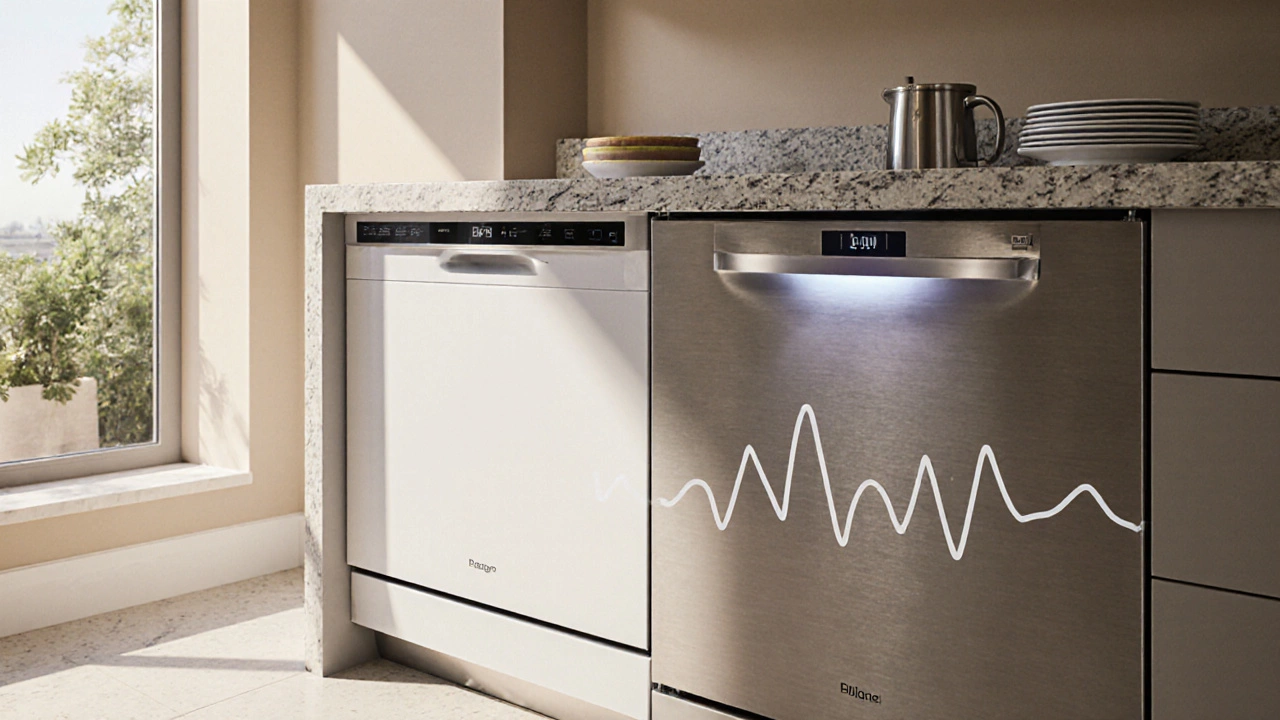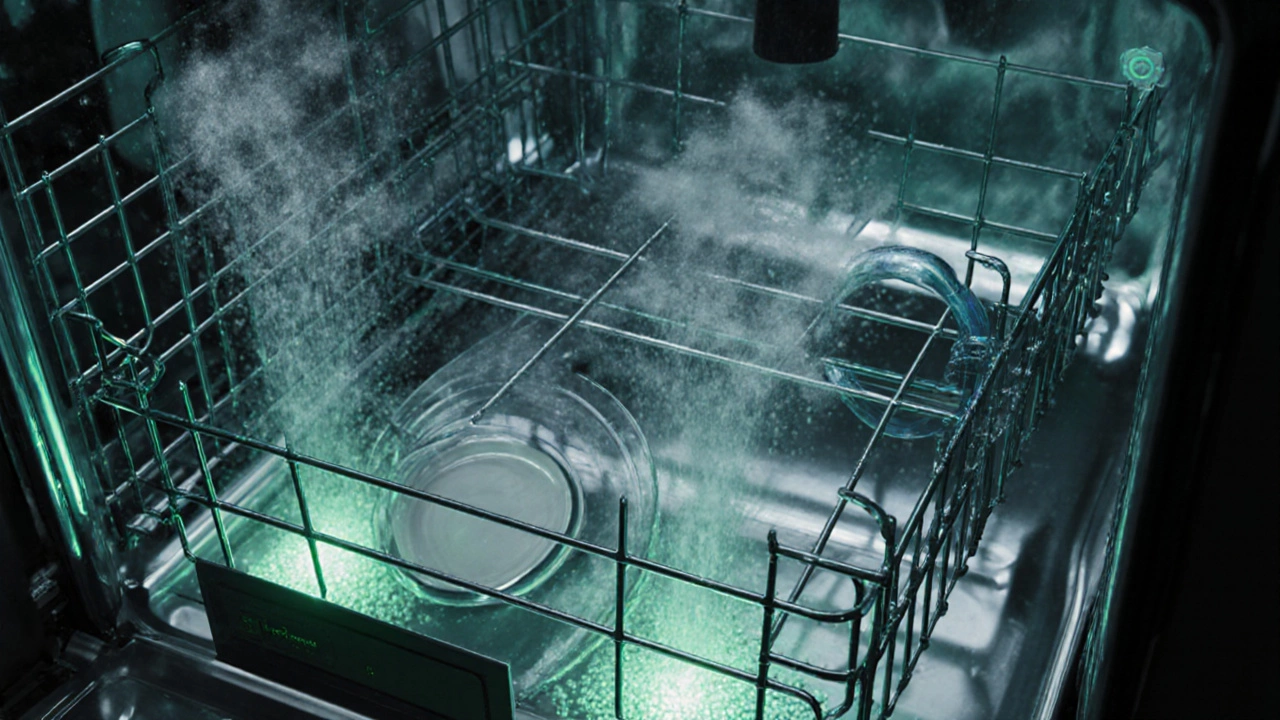
Dishwasher Energy Savings Calculator
Compare your current dishwasher efficiency with an A+++ model to see potential annual savings. Based on UK electricity costs and average usage.
Estimated Annual Savings
Upgrading to an A+++ model could save you up to £150 annually based on current energy ratings.
This represents a 0% improvement from your current model
When you’re hunting for a new dishwasher, the price tag often feels like the biggest clue. But does a higher price really mean better performance, or are you just paying for a brand name? Below we break down the real differences between cheap and expensive models so you can decide what you actually need in your kitchen.
Quick Takeaways
- Price ranges: cheap dishwashers usually cost £300‑£500, premium models start around £900 and can exceed £2,000.
- Cleaning power: premium units offer advanced wash arms, stronger jets, and more precise soil sensors.
- Drying performance: high‑end models use zeolite or heated “turbo‑dry” systems that leave dishes virtually moisture‑free.
- Noise levels: cheap machines average 48‑55dB, while expensive ones can be as quiet as 38‑42dB.
- Long‑term costs: energy‑efficient premium units (A+++ rating) can save up to £150 per year on electricity.
Defining Cheap and Expensive DishwashersDishwasher is a kitchen appliance that automatically cleans dishes, glasses, and cookware using water, detergent, and heat. In the UK market, "cheap" typically means models priced under £500, often with basic stainless steel or plastic tubs, limited wash programs, and a standard 5‑year warranty. "Expensive" or premium dishwashers start at around £900 and feature premium materials, more sophisticated electronics, and extended warranties (up to 10years). The price gap isn’t just about brand prestige-it reflects real differences in design, components, and performance.
Core Performance: Cleaning, Drying, and Noise
Three metrics dominate everyday use:
- Wash pressure is higher in premium models, often with multiple spray arms and variable pressure zones, delivering up to 15L/min water flow versus 10L/min in budget units.
- Drying systems vary: cheap dishwashers rely on residual heat (condensation drying), leaving glasses with water spots. Mid‑range and high‑end units use Zeolite drying (a mineral that absorbs moisture) or powerful fan‑assisted heated drying, cutting drying time by 30%.
- Noise level is measured in decibels (dB). A cheap model at 52dB can be heard from an adjoining room, while a premium machine at 38dB barely registers during a conversation.
Feature Set: Sensors, Racks, and Smart Connectivity
Feature‑rich dishwashers differentiate themselves through automation and flexibility.
- Soil sensor technology reads water turbidity to adjust cycle length and water usage. Basic models may have a single “Eco” setting; premium units can auto‑tune each wash.
- Adjustable racks and fold‑down tines accommodate tall pots, wine glasses, or cutting boards. Cheap machines often have fixed racks.
- Smart connectivity (Wi‑Fi, Bluetooth) lets you start, pause, or monitor cycles from a phone app. This is rare below £700.
- Premium detergents dispensers feature a dual‑compartment for pre‑wash and main wash, improving performance on heavily soiled items.
Energy Efficiency and Long‑Term Operating Costs
Energy rating (A+++‑A) directly impacts your electricity bill. A cheap dishwasher may sit at an A rating, using about 0.95kWh per cycle. A premium A+++ model drops consumption to 0.53kWh. Over 250 cycles a year, that’s roughly a £130‑£150 annual saving, which can offset the higher upfront price in 4‑5years.
Water usage also drops from 12L per cycle in entry‑level units to 8L in top‑tier models, reducing utility bills and environmental impact.

Durability, Build Quality, and Warranty
Materials matter. Cheap dishwashers often have plastic interiors prone to staining and warping. Premium units typically use stainless steel tubs, which resist corrosion, retain heat better (improving drying), and last longer.
- Stainless steel tub: extends life by 30‑40% and improves energy efficiency.
- Noise‑absorbing insulation: dense foam layers reduce vibration.
- Motor type: budget models use universal motors that wear faster; high‑end machines employ brushless DC motors with longer lifespans.
Warranty length is a confidence signal. Expect 2‑3years on cheap models, while premium brands often provide 5‑10years on the tub and motor.
Buying Checklist: What to Look for at Different Price Points
- Set a budget range.
- £300‑£500: focus on basic wash cycles, decent energy rating (A), and a reliable brand.
- £500‑£800: look for stainless steel interior and at least two spray arms.
- £900+: prioritize quiet operation (<42dB), advanced sensors, and extended warranty.
- Check the energy label (A+++ is best).
- Measure noise level if your kitchen is open‑plan.
- Assess rack flexibility-adjustable or removable tines are a must for larger cookware.
- Determine if smart features add value for you (remote start, cycle alerts).
- Read after‑sales support reviews-some budget brands skimp on parts availability.
Common Pitfalls to Avoid
- Choosing based solely on price without checking the tub material-plastic can lead to odors over time.
- Ignoring the noise rating-an “expensive” label doesn’t guarantee quiet operation.
- Overlooking the warranty-cheap models may charge extra for extended coverage.
- Assuming all “eco” cycles are equally efficient-compare actual kWh/L figures.
- Neglecting the size of the door opening-larger loads need more clearance.

Side‑by‑Side Comparison
| Feature | Budget (£300‑£500) | Premium (£900+) |
|---|---|---|
| Tub Material | Plastic | Stainless Steel |
| Energy Rating | A | A+++ |
| Noise Level | 48‑55dB | 38‑42dB |
| Wash Arms | Single | Dual + Variable Pressure |
| Drying System | Condensation | Zeolite / Turbo‑Dry |
| Soil Sensor | None or basic | Advanced auto‑adjust |
| Smart Connectivity | None | Wi‑Fi, App Control |
| Warranty | 2‑3years | 5‑10years (tub & motor) |
Final Thoughts
Price is a useful guide, but it’s the combination of tub material, energy efficiency, noise level, and intelligent features that truly separates cheap from expensive dishwashers. By matching these attributes to your household needs-size of family, kitchen layout, and tolerance for noise-you can avoid over‑paying while still getting a machine that lasts.
Frequently Asked Questions
What is the typical lifespan of a cheap versus an expensive dishwasher?
A budget model with a plastic tub often lasts 5‑7years, while a premium stainless‑steel unit can easily reach 12‑15years if maintained regularly.
Do I really need a dishwasher with a soil sensor?
If you frequently wash heavily soiled pots or bakeware, a sensor saves water and energy by adapting the wash. For light daily loads, a basic model may suffice.
How much can I save on electricity by choosing an A+++ dishwasher?
An A+++ model uses about 0.53kWh per cycle versus 0.95kWh for an A model. Over 250 cycles a year, that translates to roughly £130‑£150 in savings.
Is a quiet dishwasher worth the extra cost?
If your kitchen is open‑plan or you run the dishwasher at night, the difference between 55dB and 40dB is noticeable. A quieter unit also tends to have better vibration dampening, extending component life.
Do I need smart connectivity in a dishwasher?
Smart features are convenient for remote monitoring or integrating with voice assistants, but they don’t improve cleaning performance. Choose based on lifestyle, not just hype.